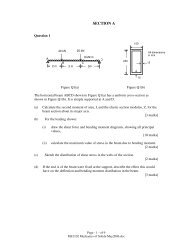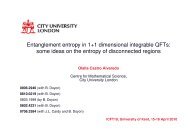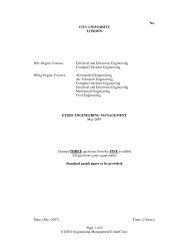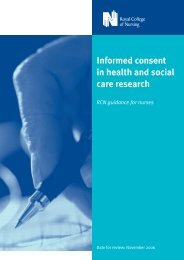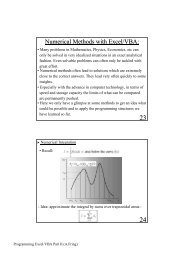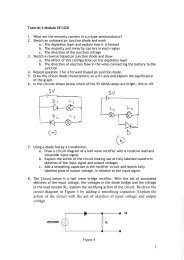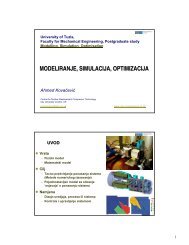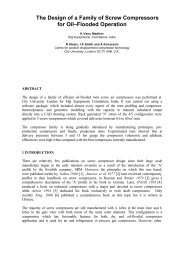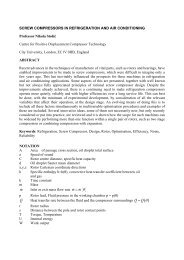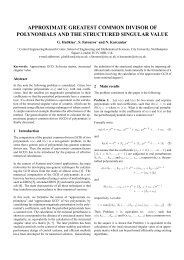Stochastic Modelling Solutions to Exercises on Time Series∗
Stochastic Modelling Solutions to Exercises on Time Series∗
Stochastic Modelling Solutions to Exercises on Time Series∗
Create successful ePaper yourself
Turn your PDF publications into a flip-book with our unique Google optimized e-Paper software.
Q6. (i) EW t = EX t +EY t is c<strong>on</strong>stant over time. The au<str<strong>on</strong>g>to</str<strong>on</strong>g>covariance of the process {W t } is<br />
Cov [W t , W t−k ] = Cov [X t + Y t , X t−k + Y t−k ] = Cov [X t , X t−k ] + Cov [Y t , Y t−k ] and<br />
depends <strong>on</strong> lag k and not <strong>on</strong> time t.<br />
(ii) X t = ln CPI t − ln CPI t−1 and hence ln CPI t = ∑ t<br />
j=−∞ X j. Since X t is an AR(1)<br />
process, it is clear that ln CPI t is ‘integrated’ <strong>on</strong>ce and is ARIMA(1, 1, 0). Alternatively,<br />
note that (1 − B)(1 − αB) ln CPI t = Z t + µ(1 − α) and a unit root<br />
occurs.<br />
<str<strong>on</strong>g>Soluti<strong>on</strong>s</str<strong>on</strong>g> <str<strong>on</strong>g>to</str<strong>on</strong>g> Past Exam Questi<strong>on</strong>s<br />
Q1. (i) (a) γ 0 = Var(e t +β 1 e t−1 ) = (1+β 2 1 )σ2 e and γ 1 = Cov [e t + β 1 e t−1 , e t−1 + β 1 e t−2 ] =<br />
β 1 σ 2 e, with γ k = 0 for k > 1.<br />
This gives ρ 0 = 1, ρ 1 = β 1 /(1 + β 2 1 ), ρ k = 0 otherwise.<br />
(b) Invertibility requires that |β 1 | < 1, so that the sum X t −β 1 X t−1 +β 2 1 X t−2 +· · ·<br />
c<strong>on</strong>verges. µ and σ e are irrelevant.<br />
(ii) We need <str<strong>on</strong>g>to</str<strong>on</strong>g> solve (1 + β 2 1 )σ2 e = 14.5, β 1 σ 2 e = 5.0. Eliminating σ 2 e, we have 1 + β 2 1 =<br />
2.9β 1 , or β 1 = 1 2 (2.9 ± √ (2.9 2 − 4)) = 2.5 or 0.4.<br />
β 1 = 2.5 corresp<strong>on</strong>ds <str<strong>on</strong>g>to</str<strong>on</strong>g> σ 2 e = 2, whereas β 1 = 0.4 corresp<strong>on</strong>ds <str<strong>on</strong>g>to</str<strong>on</strong>g> σ 2 e = 12.5.<br />
For invertibility, solve 1 + β 1 z = 0. In the first case, z = −0.4 (no good); in the<br />
sec<strong>on</strong>d, z = −2.5 (OK).<br />
(Exam Board of the Institute and Faculty of Actuaries)<br />
Q2. (i) (a) γ 1 = Cov [X t , X t−1 ] = Cov [α 1 X t−1 + α 2 X t−2 + e t , X t ] = α 1 γ 0 +α 2 γ 1 +0, since<br />
e t is independent of X t−1 .<br />
(b) Similarly γ 2 = α 1 γ 1 + α 2 γ 0 and γ 0 = α 1 γ 1 + α 2 γ 2 + Cov [X t , e t ]. A further<br />
applicati<strong>on</strong> of the same technique gives Cov [X t , e t ] = σe. 2 Thus,<br />
γ 1 = α (<br />
)<br />
1<br />
γ 0 , γ 2 = α 2 + α2 1<br />
γ 0 .<br />
1 − α 2 1 − α 2<br />
(c) ρ k is found by the relati<strong>on</strong> ρ k = γ k /γ 0 .<br />
(ii) We have ˆα 1 = r 1 (1 − ˆα 2 ) and ˆα 2 + ˆα 2 1 /(1 − ˆα 2) = r 2 , which are solved by<br />
ˆα 1 = r 1(1 − r 2 )<br />
1 − r 2 1<br />
, ˆα 2 = r 2 − r1<br />
2<br />
1 − r1<br />
2 .<br />
(Exam Board of the Institute and Faculty of Actuaries)<br />
Q3. (i) γ 1 = 0.8γ 0 − 0.4γ 1 + 0 and γ 2 = 0.8γ 1 − 0.4γ 0 + 0.<br />
Hence, γ 1 = 4 7 γ 0 and γ 2 = 2 35 γ 0, implying that ρ 1 = 4 7 and ρ 2 = 2<br />
φ 1 = ρ 1 = 4 7 and φ 2 = ρ 2−ρ 2 1<br />
= −0.4.<br />
1−ρ 2 1<br />
(ii) The acf will reduce <str<strong>on</strong>g>to</str<strong>on</strong>g> zero as k increases; the pacf, however, will be equal <str<strong>on</strong>g>to</str<strong>on</strong>g> zero<br />
for all k > 2.<br />
35 .<br />
(Exam Board of the Institute and Faculty of Actuaries)<br />
5



